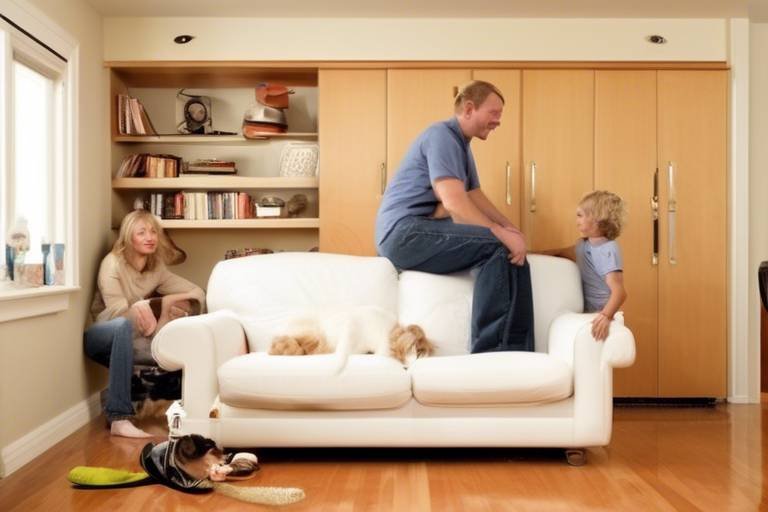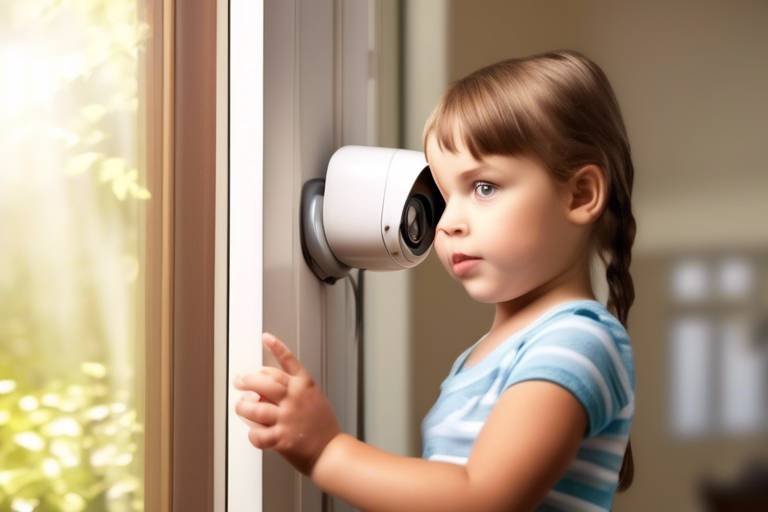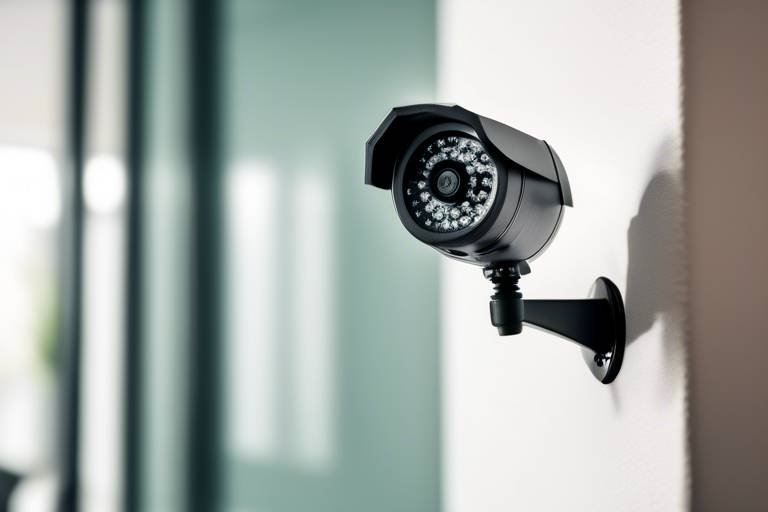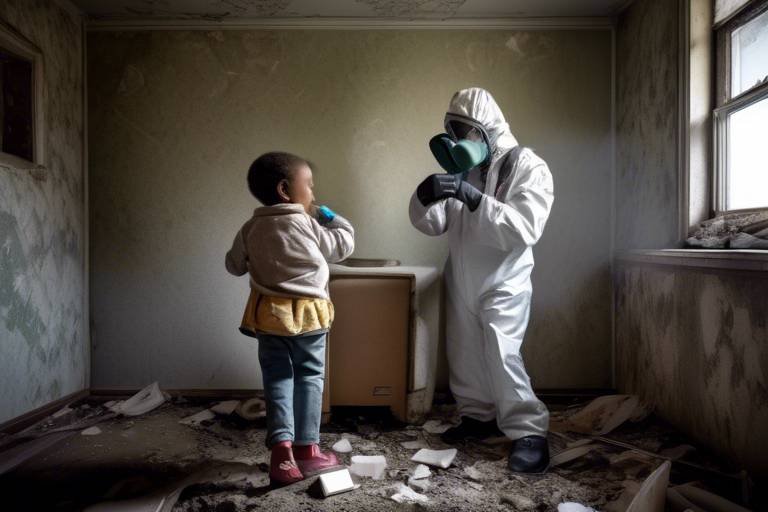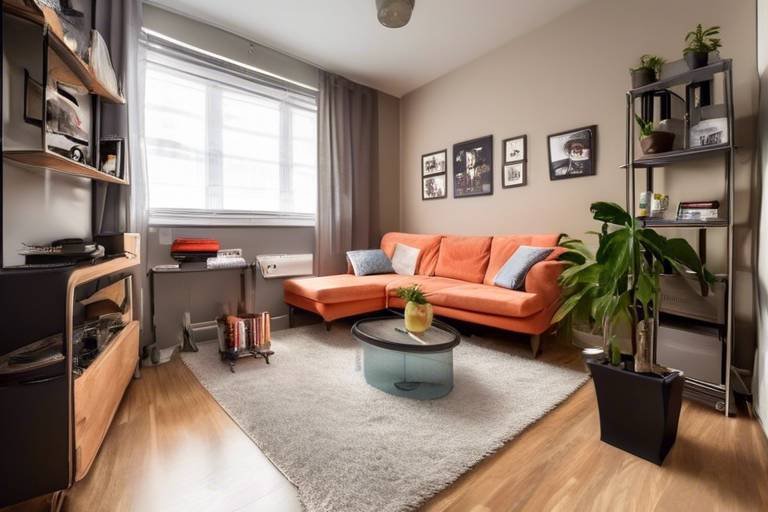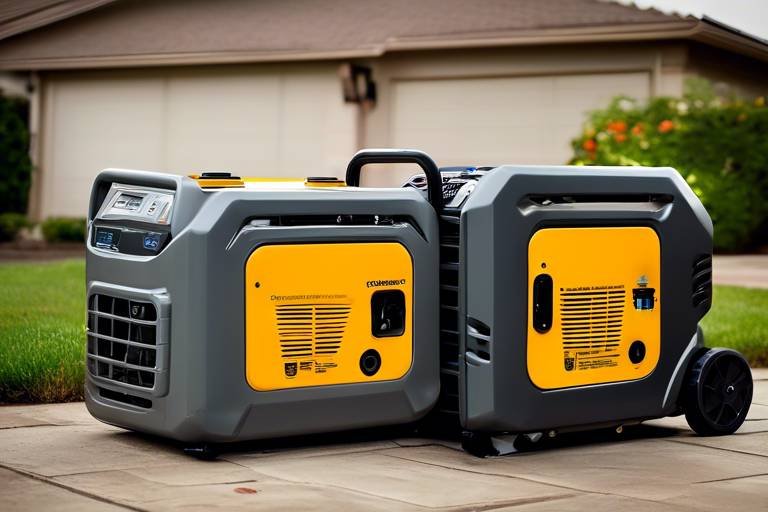How to Create a Safer Environment for Your Pets
Creating a safe haven for your furry friends is not just a responsibility; it’s a commitment to their well-being. Every pet owner knows that our beloved companions are curious by nature, and with that curiosity comes the potential for accidents and injuries. So, how can we transform our homes into pet-friendly sanctuaries? The answer lies in understanding their needs, identifying hazards, and implementing effective safety measures. In this article, we’ll explore various strategies to ensure your pets are safe and secure, from indoor safety tips to outdoor precautions and emergency preparedness. Let’s dive in!
Before we can protect our pets, we need to be aware of the common hazards lurking in our homes. Identifying these risks is crucial for creating a safe environment. For instance, many household items that we use daily can be toxic to pets. Cleaning supplies, certain foods, and even plants can pose serious threats. Additionally, choking hazards can be found in the form of small toys or household items that pets might mistakenly ingest. Understanding these dangers is the first step toward a safer home for your furry family members.
Transforming your living space into a pet-friendly environment requires thoughtful planning and a keen eye for detail. Start by arranging your furniture in a way that minimizes the risk of accidents. For instance, secure heavy items that could tip over and create a hazard. It’s also essential to pet-proof cabinets and drawers. Consider using childproof locks to keep harmful substances out of reach. Furthermore, when choosing materials for your home, opt for durable and easy-to-clean options that can withstand the wear and tear of playful pets. Remember, a little effort in creating a safe indoor space can go a long way in ensuring your pets remain happy and healthy.
Pet-proofing is more than just a precaution; it’s a necessity. Think of it as creating a fortress for your pets, where they can explore without the constant worry of danger. Here are some practical tips to help you get started:
- Secure Electrical Cords: Pets are notorious for chewing on cords. Use cord protectors or tuck them away to prevent any accidents.
- Remove Small Objects: Keep small items like coins, buttons, or toys out of reach. These can easily be swallowed and cause choking.
- Utilize Safety Gates: Install gates to block off areas that may pose risks, such as staircases or rooms with hazardous materials.
Did you know that some common houseplants can be toxic to pets? It’s true! While we love to bring greenery into our homes, it’s crucial to choose plants that won’t endanger our furry friends. Some safe options include spider plants, Boston ferns, and bamboo palms. When selecting plants, always do your research to ensure they are non-toxic. Creating a green environment that is safe for your pets can be both beautiful and worry-free!
Everyday items in our homes can pose risks to our pets. Think about it: medications, cleaning supplies, and even certain foods can be harmful if ingested. To ensure your pets' safety, store these items in high cabinets or locked drawers. Here’s a quick checklist of items to secure:
- Cleaning supplies
- Medications
- Sharp objects (knives, scissors)
- Small household items (batteries, coins)
Outdoor environments present unique challenges for pet safety. Whether it's a backyard or a park visit, ensuring your pet's safety requires vigilance. One of the first steps is to assess your outdoor space. Make sure your fencing is secure and tall enough to prevent escapes. Regularly check for any gaps or holes that your pet could squeeze through. Additionally, supervision is key. Always keep an eye on your pets when they are outside, and consider leash training for those outings to ensure they stay close and safe.
Being prepared for emergencies can save your pet's life. Emergencies can happen at any time, and having a plan in place is essential. Start by creating a pet emergency kit that includes all the necessary supplies your pet might need in case of an emergency. This kit should be easily accessible and regularly updated to ensure its effectiveness.
A well-stocked emergency kit is vital for pet safety. Here’s what you should include:
- Food and water supplies
- Medications and medical records
- First aid supplies (bandages, antiseptic)
- Leash and carrier for transportation
Having a safety plan ensures you're ready in case of emergencies. This plan should outline evacuation routes and safe locations for your pets during disasters. Regularly practice your plan with your pets, so they become familiar with it. Think of it as a rehearsal for a play – the more you practice, the smoother it will go when it really counts!
Q: What should I do if my pet ingests something toxic?
A: If you suspect your pet has ingested something toxic, contact your veterinarian or an emergency animal poison control hotline immediately. Time is of the essence!
Q: How can I tell if my plants are safe for pets?
A: Research the specific plants you have at home. Many online resources provide lists of toxic and non-toxic plants for pets, helping you make informed decisions.
Q: What are some signs that my pet might be in danger indoors?
A: Watch for signs of distress such as vomiting, lethargy, or unusual behavior. If you notice anything concerning, consult your veterinarian right away.

Understanding Pet Hazards
When it comes to keeping our beloved pets safe, understanding potential hazards in our homes is the first step. Just like a parent would child-proof their home, pet owners need to be vigilant about the dangers that lurk around every corner. Did you know that many common household items can pose serious risks to your furry friends? From toxic substances to choking hazards, being aware of what could endanger your pets is crucial.
Let's start with toxic substances. Many household cleaners, medications, and even certain foods are harmful to pets. For instance, chocolate, grapes, and onions are not just human delicacies; they can be deadly for dogs and cats. Similarly, common cleaning agents like bleach and ammonia can cause severe health issues if ingested. It’s essential to keep these items securely stored and out of reach. A good rule of thumb is to treat your pet like a curious toddler—if it’s potentially harmful, it should be kept high and locked away!
Choking hazards are another significant concern. Pets, especially dogs, are notorious for chewing on things they shouldn't. Small objects like coins, buttons, or even toys with small parts can easily become choking risks. To mitigate this, conduct a thorough sweep of your living space, removing any small items that could be swallowed. Think of it as a scavenger hunt—only instead of looking for treasure, you’re on the lookout for potential dangers.
In addition to these hazards, keep an eye out for other risks that can threaten your pets' safety. Here are a few common ones:
- Electrical cords: Pets love to chew, and exposed cords can lead to serious injuries or even fatal shocks.
- Houseplants: Some plants are toxic to pets, so it's important to research and choose non-toxic options.
- Open windows and balconies: Curious pets may try to escape or fall, so ensure they are secure.
By taking these precautions, you can significantly reduce the risks your pets face at home. Remember, a safe environment is a happy environment for both you and your furry companions. In the end, understanding pet hazards isn’t just about avoiding accidents; it’s about creating a nurturing space where your pets can thrive and feel secure. So, take a moment to assess your surroundings and make adjustments as necessary. Your pets will thank you with wagging tails and purring cuddles!

Safe Indoor Spaces
Creating a pet-friendly indoor environment is not just about aesthetics; it’s about ensuring your furry companions can roam freely and safely. Imagine your home as a sanctuary where your pets can play, explore, and relax without the constant worry of potential hazards lurking around every corner. To achieve this, careful planning and a keen eye for detail are essential. Start by examining your living space and identifying areas that could pose risks. For instance, low-hanging cords from lamps and electronics can be tempting chew toys for curious pets. By securing these cords with clips or running them along walls, you can significantly reduce the chances of accidents.
Another critical aspect of creating safe indoor spaces is pet-proofing your cabinets. Many pet owners may not realize that common household items, such as cleaning supplies and medications, can be lethal if ingested. Installing childproof locks on cabinets can keep your curious pets at bay. Think of it as setting up a fortress; you want to keep the treasures inside (the cleaning products) locked away from the little adventurers (your pets) who might stumble upon them. Additionally, consider the materials you choose for your furniture and decor. Opt for fabrics that are durable and easy to clean, as pets can be prone to accidents.
Pet-proofing goes beyond just securing cords and locking up dangerous items. It’s about creating a holistic environment that fosters safety and comfort. For example, using safety gates to restrict access to certain areas of your home can be a game-changer. If you have a home office or a room with fragile items, a safety gate can act as a barrier, keeping your pets safe from potential hazards. Additionally, remember to remove small objects that could pose choking hazards. This includes items like coins, buttons, and small toys that can easily be swallowed. Regularly scanning your living space for these hidden dangers can make a world of difference.
Many people love to add a touch of greenery to their homes, but did you know that some houseplants can be toxic to pets? It’s essential to choose non-toxic plants that can thrive indoors without posing a risk to your furry friends. Consider plants like spider plants, Boston ferns, and bamboo palms, which are not only safe but also enhance your home’s aesthetic. Creating a green environment that won’t endanger your pets is like setting up a mini jungle for them to explore safely. Always do your research before bringing a new plant home, and don’t hesitate to consult your veterinarian for recommendations.
Everyday items can become dangerous if not stored correctly. Think about it: how many times have you left a bottle of cleaning supplies on the counter, only to realize later that your pet could easily reach it? It’s crucial to store these items safely out of reach. Use high cabinets for hazardous materials and always ensure that lids are tightly secured. Additionally, keep your pet’s toys organized and in a designated area to avoid clutter and potential choking hazards. By being proactive about securing dangerous items, you’re not just protecting your pets; you’re also creating a more organized and peaceful living space for everyone.

Pet-Proofing Your Home
Pet-proofing your home is not just a good idea; it's a necessity if you want to keep your furry companions safe and sound. Imagine your curious cat or playful puppy exploring every nook and cranny of your house. While their adventurous spirit is adorable, it can also lead to dangerous situations if your home isn't properly secured. The first step in creating a safe haven for your pets is to assess your living space for potential hazards.
Start by taking a good look around your home. Are there electrical cords dangling enticingly from the wall? Is there a tempting pile of small objects on the coffee table just waiting to be swallowed? These seemingly harmless items can turn into serious choking hazards or cause severe injuries. To combat this, consider using cord organizers or clips to secure those pesky wires out of reach. Additionally, it's wise to remove any small items, like coins or buttons, that your pets might mistake for toys.
Another essential aspect of pet-proofing is utilizing safety gates. These handy barriers can effectively keep your pets out of restricted areas, like the kitchen or stairs. It's like putting a "no entry" sign on the areas where potential dangers lurk. Just think about it: how many times have you turned your back for a second only to find your puppy has gotten into the trash? With safety gates, you can minimize those heart-stopping moments.
Moreover, don’t forget about the importance of securing cabinets and drawers. Pets are often more resourceful than we give them credit for, and they can quickly figure out how to open doors or drawers if they’re not properly secured. Use child-proof locks to keep your cleaning supplies, medications, and other hazardous materials tucked away safely. This simple step can prevent a world of trouble and keep your pets out of harm's way.
When it comes to pet-proofing your home, you also need to consider the materials you choose. Opt for durable fabrics that can withstand the wear and tear of your pets’ claws and claws. Think about it: a couch covered in delicate fabric might seem stylish, but it won’t hold up against a playful puppy's enthusiasm. Instead, go for materials that are both comfortable and easy to clean, such as microfiber or leather. Your home will look great, and you’ll spend less time worrying about stains or damage.
In summary, pet-proofing your home is all about being proactive. By taking the time to secure your space, you can create a safe environment where your pets can thrive without constant supervision. Remember, a little effort now can save you from a lot of heartache later. So grab your pet-proofing checklist, and let’s get started on making your home a sanctuary for your furry friends!
Q: How can I tell if my home is pet-proofed?
A: Walk through your home as if you were a curious pet. Look for hazards like cords, small objects, and unsecured cabinets. If you see something that could pose a risk, take steps to eliminate it.
Q: Are there specific plants I should avoid?
A: Yes! Some common houseplants like lilies and philodendrons can be toxic to pets. Always research plants before bringing them into your home.
Q: What are the best materials for pet-friendly furniture?
A: Look for durable and easy-to-clean materials like microfiber, leather, or canvas. These fabrics can withstand scratches and are easier to maintain.

Choosing Non-Toxic Plants
When it comes to creating a vibrant indoor space, plants can add a touch of life and color. However, as a pet owner, it's crucial to choose non-toxic plants to ensure your furry friends remain safe. Many common houseplants can be harmful or even fatal if ingested by pets. So, how do you select the right plants without compromising your pets' health? First, let’s look at some popular non-toxic options that are both beautiful and safe.
Some great choices include:
- Spider Plant: Not only is this plant easy to care for, but it also helps purify the air!
- Bamboo Palm: This plant thrives in low light and adds a tropical vibe to your home.
- Boston Fern: A lush, green addition that can help maintain humidity levels indoors.
- Areca Palm: Safe for pets and a fantastic air purifier, this plant can grow quite tall, making it a striking focal point.
While these plants are safe, it’s essential to keep in mind that even non-toxic plants can cause mild digestive upset if ingested in large quantities. Therefore, it’s wise to monitor your pets around greenery. Additionally, consider the placement of your plants. Hanging pots or high shelves can deter curious paws from reaching them. Think of it as creating a safe zone where your plants can thrive without the risk of becoming a chew toy!
Moreover, if you’re looking to create a pet-friendly garden, there are outdoor plants that are equally safe for your pets. Some examples include:
- Rosemary: Not only a culinary delight, but also safe for pets.
- Marigolds: Bright and cheerful, these flowers deter pests and are safe for animals.
- Snapdragons: These colorful blooms can be a safe addition to your garden.
Incorporating non-toxic plants into your home doesn't just enhance aesthetics; it can also promote a healthier environment for both you and your pets. Imagine walking into a room filled with greenery, sunlight filtering through the leaves, and your pets happily exploring their safe haven. It’s a win-win situation! Just remember to do your research and verify the safety of any new plant before bringing it home. Your pets will thank you for it!
As we dive deeper into the world of pet safety, it’s also vital to stay informed about the plants you already have. If you’re unsure whether a plant is safe, you can easily find resources online or consult with your veterinarian. Keeping your pets safe is a top priority, and choosing the right plants is a significant step in that direction.
Q: How can I tell if a plant is toxic to my pet?
A: You can research the plant online or consult with your veterinarian. Many websites provide lists of toxic and non-toxic plants for pets.
Q: What should I do if my pet ingests a toxic plant?
A: Contact your veterinarian immediately or call a pet poison control hotline for guidance.
Q: Are there any pet-safe alternatives to common houseplants?
A: Yes! Many non-toxic plants can replace common toxic varieties. For example, instead of a pothos, consider a spider plant.

Securing Dangerous Items
When it comes to our furry companions, safety is always the top priority. One of the most critical steps in ensuring a safe environment for your pets is to secure dangerous items around your home. Think about it: your pet is naturally curious and often gets into things that can cause harm. From cleaning supplies to medications, these everyday items can pose serious risks if not stored properly.
First, let's talk about cleaning supplies. Many household cleaners contain chemicals that are toxic to pets. Just imagine your curious cat or dog sniffing around and accidentally ingesting something harmful. To prevent this, always store cleaning products in high cabinets or locked spaces. Consider using childproof locks to keep those curious paws away from danger. If you have to keep these items under the sink, make sure they are in a cabinet that your pet cannot access.
Next on the list are medications. It’s easy to forget how potent our prescription and over-the-counter medications can be. A single pill can be fatal to a small pet. Make it a habit to keep all medications in a secure location, preferably a cabinet with a childproof latch. Additionally, never leave pills out on counters or tables where pets can reach them. If you have guests over, kindly remind them to keep their bags and belongings out of reach as well.
Another area of concern is the garage or utility room, which often houses tools and other hazardous materials. Items like antifreeze, paints, and even batteries can be extremely dangerous for pets. Ensure that these items are stored in cabinets that are out of reach and preferably locked. It’s like creating a fortress for your pets, where only safe and approved items are allowed inside.
Lastly, it’s essential to consider other smaller items that may not seem dangerous but can be choking hazards or cause intestinal blockages. Things like rubber bands, hair ties, and small toys should be stored in drawers or containers that pets cannot access. It’s a good idea to regularly check your home for any small objects that might have fallen to the floor or been left out. Think of it as a treasure hunt, but instead of looking for gold, you’re searching for potential hazards!
By taking these steps to secure dangerous items, you’re not just protecting your pets; you’re also giving yourself peace of mind. Remember, a little bit of prevention goes a long way in keeping your furry friends safe and sound. So, go ahead and take a look around your home today. You might just find a few things that need to be tucked away!
- What should I do if my pet ingests a toxic substance?
Immediately contact your veterinarian or an emergency animal poison hotline for guidance. - How can I tell if a plant is toxic to my pet?
Research the plants you have at home or consult with your vet to ensure they're safe for pets. - What are some signs of poisoning in pets?
Common signs include vomiting, diarrhea, lethargy, and unusual behavior. If you notice these symptoms, seek veterinary help right away. - Are there any pet-safe cleaning products?
Yes, many brands offer non-toxic cleaning solutions specifically designed for homes with pets.

Outdoor Safety Measures
When it comes to the great outdoors, ensuring your pet's safety is paramount. Just like a parent keeps an eye on their child at the playground, you must be vigilant when your furry friend is outside. Outdoor environments can be filled with potential hazards, and understanding these challenges is the first step in keeping your pet safe. One of the most critical aspects of outdoor safety is having a secure, enclosed area for your pets to roam. A sturdy fence, ideally at least six feet high, can prevent your pet from escaping and keep unwanted animals out. However, not all fences are created equal; make sure there are no gaps or weak spots where your pet could squeeze through.
But what about the times when your pet is not in a fenced area? This is where supervision comes into play. Always keep an eye on your pet when they are outside, especially in unfenced areas. It’s easy to get distracted, but a moment of inattention could lead to your pet wandering off or getting into trouble. Additionally, leash training is essential. A well-trained dog on a leash can enjoy outdoor adventures without the risk of chasing after a squirrel or running into traffic. Think of the leash as a lifeline; it keeps your pet connected to you, ensuring their safety while allowing them to explore.
Moreover, consider the environment around you. Are there any plants or flowers in your yard that could be harmful to your pet? Certain plants can be toxic, and it’s crucial to identify and remove them. For instance, azaleas and lilies can be dangerous if ingested. If you’re unsure about the safety of your plants, consult with a veterinarian or do some research on pet-friendly landscaping options. You can create a beautiful garden that is also safe for your pets; it just takes a bit of planning.
Another outdoor safety measure involves being mindful of the weather. Hot days can pose a significant risk for pets, leading to heatstroke or dehydration. Always provide shade and fresh water, and avoid exercising your pet during the hottest parts of the day. On the flip side, cold weather can also be harsh, especially for small or short-haired breeds. Consider investing in a pet jacket for those chilly walks, and make sure your pet has a warm place to retreat to when the temperatures drop.
Lastly, it’s important to be aware of your surroundings. Whether you’re at a park or on a hiking trail, watch for wildlife that could pose a threat. Raccoons, coyotes, and even snakes can be dangerous to pets. Keeping your pet on a leash in these situations not only protects them but also helps you maintain control. In summary, outdoor safety measures are about creating a secure environment, being aware of potential hazards, and ensuring your pet is supervised and trained. By taking these precautions, you can enjoy the outdoors together while keeping your beloved pet safe.
- What should I do if my pet escapes the yard? - Stay calm and search the surrounding area. Notify your neighbors and local animal shelters, and consider using social media to spread the word.
- How can I tell if a plant is toxic to my pet? - Research online or consult your veterinarian. Many resources list common household and garden plants that are safe or toxic to pets.
- What are the signs of heatstroke in pets? - Look for excessive panting, drooling, weakness, or confusion. If you suspect heatstroke, move your pet to a cooler area and contact a veterinarian immediately.

Emergency Preparedness
When it comes to our beloved pets, being prepared for emergencies is not just a good idea; it's a necessity. Imagine the panic of a sudden storm, a fire, or even an unexpected evacuation. In those moments, having a plan can make all the difference. You wouldn't want to scramble for your pet's essentials while chaos unfolds around you, right? So, let’s dive into how you can create a solid emergency preparedness plan that keeps your furry friends safe and sound.
The first step is to assemble a Pet Emergency Kit. Think of it as your pet's survival backpack, stocked with everything they might need in a crisis. This kit should include:
- Food and Water: Enough supplies to last at least three days.
- Medications: Any prescription medications your pet requires, along with a list of dosages and administration instructions.
- First Aid Supplies: Bandages, antiseptic wipes, and any specific items your pet might need.
- Identification: Ensure your pet has a collar with an ID tag and consider microchipping for added security.
- Comfort Items: A favorite toy or blanket can help soothe your pet during stressful situations.
Now that you've got the basics covered, it’s time to think about your Safety Plan. This plan should outline what to do in various emergency scenarios. For instance, if you live in an area prone to natural disasters, you should have an evacuation plan that includes your pets. Here are some key considerations:
- Identify safe locations where you can take your pets, such as pet-friendly hotels or friends' homes.
- Practice your evacuation plan with your pets so they become familiar with the routine.
- Keep a list of local veterinarians and pet emergency clinics handy, just in case you need them.
Lastly, don’t forget to regularly update your emergency kit and safety plan. Just like we change our smoke detector batteries, we need to refresh our pet's emergency supplies. Check expiration dates on food and medications, and ensure that your pet's ID information is current. By taking these proactive steps, you can ensure that your pets remain safe and secure, even when the unexpected happens.
Q: How often should I check my pet emergency kit?
A: It's a good idea to review your pet emergency kit every six months to ensure everything is up to date and in good condition.
Q: What should I do if I have multiple pets?
A: Make sure to have a separate emergency kit for each pet, tailored to their specific needs. Additionally, practice your evacuation plan with all pets to ensure everyone is ready.
Q: How can I keep my pet calm during an emergency?
A: Familiar items like toys or blankets can help soothe your pet. Training them to respond to commands and practicing your emergency plan can also reduce anxiety during a crisis.

Creating a Pet Emergency Kit
When it comes to ensuring the safety of your beloved pets, being prepared for emergencies is as essential as having a first aid kit for yourself. A well-stocked Pet Emergency Kit can be a lifesaver in critical situations, whether it's a natural disaster, a sudden illness, or an unexpected accident. Imagine being in a panic, your furry friend in distress, and realizing you don’t have the necessary supplies on hand. That’s why taking the time to assemble a comprehensive emergency kit is crucial.
Your pet emergency kit should include a variety of items tailored to your pet's specific needs. Start by considering the basics: food and water. It's recommended to have at least a three-day supply of both, as emergencies can disrupt access to your usual resources. Pack non-perishable food that your pet is accustomed to, and don’t forget to include a portable water bowl. It’s like having a little buffet ready for your pet when they need it most!
In addition to food and water, medications are another vital component of your kit. If your pet requires any daily medications, ensure you have an ample supply stored in your emergency kit. It’s also wise to include a copy of your pet’s medical records, vaccination history, and any pertinent health information. This way, if you need to seek veterinary care during an emergency, you have all the important details at your fingertips.
First aid supplies are equally important. Think of it as a mini hospital for your pet. Essential items might include:
- Gauze and adhesive tape
- Antiseptic wipes
- Scissors
- Thermometer
- Emergency contact information for your veterinarian
Don’t forget about comfort! Including a favorite toy or blanket can provide emotional support for your pet during stressful times. Just like humans, pets can feel anxious and scared during emergencies. Having something familiar can help soothe their nerves.
Lastly, consider how you will transport your pet in case of an evacuation. A sturdy pet carrier or crate is essential. Make sure it’s well-ventilated and large enough for your pet to stand, turn around, and lie down comfortably. It’s like their little safe haven on the go!
Once you've gathered all these items, store them in a durable, waterproof container that’s easy to grab in case of an emergency. Regularly check the contents of your kit to ensure everything is up to date, especially food and medications that may have expiration dates. Just like you wouldn’t want to rely on stale snacks during a crisis, your pet deserves the freshest supplies available!
In summary, creating a pet emergency kit is not just a good idea; it’s a necessity. By taking the time to prepare, you’re not only ensuring your pet's safety but also giving yourself peace of mind. So, take a moment today to gather those supplies, and you’ll be ready to face any challenge that comes your way with your furry friend by your side.
Q: How often should I check my pet emergency kit?
A: It's recommended to check your pet emergency kit every six months to ensure that all items are up to date, especially food and medications.
Q: What if my pet has special dietary needs?
A: If your pet has specific dietary requirements, make sure to include their special food in the emergency kit. You might also want to consult with your veterinarian for additional recommendations.
Q: Should I include my pet's favorite toys in the emergency kit?
A: Yes! Including a favorite toy or blanket can help comfort your pet during stressful situations, making it an important part of your emergency kit.

Developing a Safety Plan
When it comes to our furry family members, being prepared for emergencies is not just a good idea; it's a necessity. Imagine the chaos of a natural disaster or an unexpected situation where you need to evacuate your home. Having a well-thought-out safety plan can mean the difference between safety and panic. So, how do you go about creating this plan? Let's break it down into manageable steps.
First and foremost, it's crucial to identify safe locations for your pets during emergencies. This could be a friend's house, a family member's place, or even a pet-friendly hotel. Make sure to visit these places beforehand so your pets can get familiar with them. This way, when the time comes to evacuate, they won’t feel as stressed or confused. Additionally, consider the distance and accessibility of these locations; you don't want to be scrambling for a place that’s too far away when time is of the essence.
Next, you should create a detailed evacuation plan. This plan should include the quickest routes out of your home and neighborhood, ensuring you know the best ways to get to your designated safe locations. It's also wise to keep a pet emergency kit ready to go. This kit should include essentials like food, water, medications, and a first-aid kit, all packed in a sturdy, easy-to-carry bag. You can refer to the table below for a comprehensive list of items to include in your emergency kit:
| Item | Description |
|---|---|
| Food | Non-perishable pet food for at least a week. |
| Water | Enough water for at least a week, plus bowls. |
| Medications | Any prescription medications your pet may need. |
| First Aid Supplies | Bandaids, antiseptic wipes, and any other first aid items. |
| Leash and Carrier | Ensure you have a sturdy leash and a carrier for transport. |
Another aspect to consider is communication. Make sure everyone in your household knows the safety plan. This includes who is responsible for what during an emergency. For instance, if you have multiple pets, designate who will grab which pet and who will handle the emergency kit. Communication is key to ensuring that everyone is on the same page and can act swiftly when needed.
Lastly, don’t forget to practice your safety plan. Just like fire drills in schools, having practice runs at home can help both you and your pets feel more comfortable with the plan. This can also help you identify any potential issues that could arise during an actual emergency. By familiarizing your pets with their carriers and the evacuation routes, you can help reduce their anxiety when the real situation occurs.
In summary, developing a safety plan for your pets is an essential step in ensuring their well-being during emergencies. By identifying safe locations, creating an evacuation plan, preparing an emergency kit, communicating responsibilities, and practicing the plan, you can provide a sense of security for both you and your furry companions. Remember, when it comes to emergencies, preparation is the best defense!
- What should I include in my pet emergency kit? Make sure to include food, water, medications, a first-aid kit, and any comfort items like toys or blankets.
- How often should I update my safety plan? Review and update your safety plan at least once a year or whenever there are changes in your household.
- Can I use a regular carrier for my pet during an emergency? Yes, as long as it is sturdy and your pet is comfortable in it.
Frequently Asked Questions
- What are some common household hazards for pets?
Common household hazards for pets include toxic substances like cleaning supplies, certain plants, and foods that are harmful to them. Additionally, choking hazards such as small toys or household items can pose significant risks. It's crucial to identify these dangers and take preventive measures to keep your furry friends safe.
- How can I pet-proof my home effectively?
Pet-proofing your home involves several strategies. Start by securing electrical cords and removing small objects that could be swallowed. Use safety gates to restrict access to hazardous areas and ensure that cabinets are locked or secured. Additionally, consider the layout of your furniture to minimize the risk of accidents.
- Which houseplants are safe for pets?
When choosing houseplants, it's essential to select non-toxic varieties. Some pet-friendly options include spider plants, Boston ferns, and bamboo palms. Always research before bringing a new plant into your home to ensure it won't harm your beloved pets.
- What should I include in a pet emergency kit?
A well-stocked pet emergency kit should include essentials such as food, water, medications, a first aid kit, and any necessary documents like vaccination records. Don't forget to add comfort items like a favorite toy or blanket to help your pet feel secure during stressful situations.
- How do I create a safety plan for my pets in case of emergencies?
Creating a safety plan for your pets involves several steps. First, identify safe locations where your pets can go during emergencies. Next, develop an evacuation plan that includes how to transport your pets safely. Regularly practice this plan to ensure everyone in your household knows what to do when the time comes.







